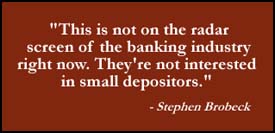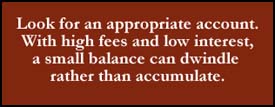|
Start your kids saving early
|
 |
October 26, 1999: 6:05 a.m. ET
Look for friendly accounts to teach your children about finances
By Staff Writer Alex Frew McMillan
|
NEW YORK (CNNfn) - With Pokemon and Barbie dominating kids' thoughts, it's hard for parents to even consider teaching their kids about banking and investing.
But kids -- especially those getting an allowance -- learn to understand money at a young age. And certainly by the time kids are in their teens, they're well on their financial way -- teen-agers earned as much as $141 billion in 1998, a third from gifts and the rest from their earnings.
Some in the financial industry believe our spending and saving habits are shaped as young as between 5 and 7 years old, deciding whether we'll wind up spenders or savers.
"It's extremely important that kids learn the importance of savings," said Catherine Pulley, spokeswoman for the American Bankers Association. With high personal bankruptcy, low savings rates and credit apparently everywhere, "now more than ever it's important to teach people the value of good financial fitness."

Options may be limited
But parents who wish to teach their kids financial discipline may not find choice in the marketplace. Many banks have educational programs of some sort, but appealing to children isn't a big concern.
"This is not on the radar screen of the banking industry right now," said Stephen Brobeck, executive director of the watchdog group Consumer Federation of America. "They're not interested in small depositors."
Understandably, most kid-oriented accounts carry small balances, so they aren't profitable for banks. In fact, with the cost of printing up statements and mailing them, kids' accounts can end up costing the bank much more than the bank stands to make.
The two-largest U.S. banks, Citibank and Bank of America, for instance, run educational programs for kids but don't have accounts specific for children. Citibank pays $10 to children that go to its kids' days, when they get a tour of the bank. But afterward, they can only open a typical savings account.
Bank of America has discounts for high-school and college students, and it runs a program in certain elementary schools. Students run a bank and open savings accounts they can withdraw from at the end of the school year. But it's limited to 23 schools in the Southeast.

Smaller banks are also getting involved with education programs. For instance, there's the Banking on Kids program in Wisconsin. Founder Ed Anhalt started it five years ago, and participation includes 15 banks in and around Milwaukee and 75 schools. School children save up in the classroom. Once they hit $10 they open a savings account with the sponsor bank.
Anhalt thinks the program is successful because it reaches children before their habits are set. "We've got first graders who are learning terms like principal and compound interest (and) Federal Reserve," he said.
As scary as that might sound, it serves a valuable purpose, he said. There's a lack of interest in serving children, particularly in inner cities, and in some cases the children's parents don't use a bank.
Anhalt is working to establish the program in Minnesota and Iowa, and talking about bringing it to New York.
Set up your own account for a kid
But parents looking to establish accounts for the kids themselves can find some attractive ones.
Cleveland-based KeyCorp has the kind of account parents might want to look for. Its DinoSaver account, for children under 18, doesn't charge a monthly fee and doesn't have a minimum balance. Kids get a newsletter and a gift. With 300,000 accounts, the bank considers it pretty successful and says it helps build loyalty with parents.
Kids can start learning how to handle money as soon as they get an allowance, said Brobeck. Parents should consider putting the minimum balance into a savings account for a kid, he said, and to consider increasing the size of the allowance if a child is using it to save.

Check the terms of the account carefully. "On some small accounts, the fees are so high and the interest is so low that the savings dwindle rather than accumulate," Brobeck said.
In particular, if you're opening an account for a child to use, make sure there are:
- No limit on transactions
- No penalty for small deposits
More banks should have suitable accounts, he thinks, and suggests that parents look for ones that do. "We strongly encourage financial institutions to promote savings by young people," Brobeck said. "It's important to learn savings."
Set up an investment for your kids
Parents might also want to think about establishing an investment account for their child's future. Family members can contribute stock as well as money in the child's name, and the child can start to help manage the account when he or she gets older.
When you're looking at an investment account, Brobeck said, do some comparison shopping. Check the yield and make sure you understand the investment strategy of any funds you invest in.
Charlotte, N.C.-based First Union started what it calls a CAP First for Kids account two years ago, which combines a bank and brokerage account. Unlike the normal CAP, or capital management, account, there's no fee until the child turns 18 -- when he or she can choose to close it. The other main differences are that there's no credit card or possibility of a margin account.
It carries a hefty minimum balance, $5,000, which would be no small obstacle to many families. It's designed for parents and grandparents to invest money or stock on a child's birthday or at the year-end holidays, perhaps, and allow the child to get involved in managing the account in middle school or high school.

First Union says that around 15,000 people have opened the special kids accounts.
First Union also has games on its Web site that try to teach kids about investing. Though the site, which rolled out in October with three games, is very limited at the moment, the bank plans to expand it in the future.
"We're trying to emphasize both investing for the future and the education part of it," Mark Folk, a First Union spokesman, said. The bank thinks its kid-oriented asset-management program is unique, he added.
Parents might want to consider investments that appeal to kids, to get them interested. Republic National Bank of New York started an account for kids last year called the Republic Young Investors, which invests in the Stein Roe Young Investor mutual fund.
The fund invests in products that children understand and might be interested in, such as Coca-Cola (KO), Nike (NKE), Disney (DIS) and the like.
Relatives can put other stock gifts in the brokerage account if they want. Stein Roe itself is offering the fund with no minimum initial investment, but there's a minimum balance of $1,000 to avoid a monthly service charge. Republic doesn't have a minimum balance.
Republic also offers a kid-oriented bank account, Bank for Kids, which includes a free savings account, though it doesn't market it extensively now it has started the Young Investors program. Parents have to keep the account open for a year to avoid a penalty for withdrawing the money. Most of the 5,000 accounts are well under $1,000.
"This is really designed for kids, to give them a sense of what the market is," said Christopher O'Gorman, president and CEO of Republic Financial Services. The rest is up to the family. "We can hold events and bring them [children] in," O'Gorman said. "But I think a lot of it has to do with the parents."
|
|
|
|
|
 |

|

